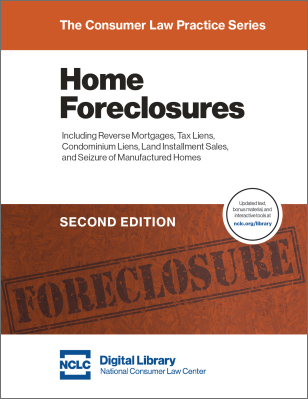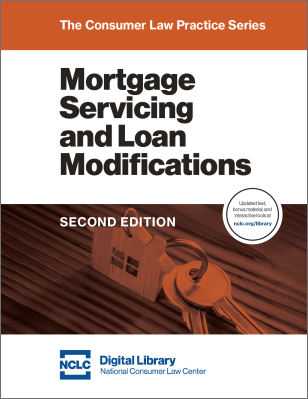This article summarizes three important policy updates from federal agencies that will help homeowners avoid foreclosure:
- The VA’s implementation of the VA Servicing Purchase (VASP) program;
- FHA’s announcement of the Payment Supplement option; and
- HUD’s promulgation of a final rule to strengthen the Section 184 Indian Housing Loan Guarantee.
The most important initial step an advocate should take to assist a client facing foreclosure is to determine what loss mitigation rules apply—both the new policies discussed below as well as any other existing options.
Critically, the loss mitigation rules applicable for a given homeowner are those imposed by the entity that is the ultimate investor in the loan, either through owning it, insuring it, or guaranteeing it—typically the VA, FHA, RHS, Fannie Mae, Freddie Mac, or a private investor. NCLC’s Mortgage Servicing and Loan Modifications § 6.1.2, discusses ways to identify whether a homeowner’s loan has a federally backed investor.
The next step is to review the applicable entity’s loss mitigation rules. Federally backed entities have publicly available loss mitigation guidelines, and they are all analyzed at NCLC’s Mortgage Servicing and Loan Modifications Chapter 7 (Fannie and Freddie), Chapter 8 (FHA), and Chapter 9 (VA and RHS). Each of these chapters should be read in conjunction with three new policies discussed below, not yet included in the digital version of the treatise.
New VA-Guaranteed Program to Help Veterans in Default
Since October 2022, homeowners with VA-guaranteed mortgages facing financial hardship have had severely limited options to retain their homes and avoid foreclosure. This is the result of the combination of the recent, dramatic increase in mortgage interest rates and a decision by VA to discontinue its partial claim program that had allowed homeowners who could resume their mortgage payments to repay the missed payments at the end of their loans. Because of this, the mortgage relief options available for veteran borrowers have been less favorable than the options available to other federally backed borrowers.
On November 17, 2023, VA urged servicers to pause foreclosure of VA-guaranteed mortgages until May 31, 2024, to give VA time to release and implement a program to fill the gap in loss mitigation options. According to VA Circular 26-23-25, “[t]o help ensure comprehensive home retention efforts, VA is strongly encouraging a foreclosure moratorium on all VA-guaranteed loans through May 31, 2024. Effective immediately, VA urges servicers to cease initiating, continuing, and/or completing foreclosures on all VA-guaranteed loans during this moratorium. This moratorium does not apply to vacant or abandoned properties.” Advocates should raise this language in response to any efforts by VA-guaranteed mortgage servicers to pursue foreclosure.
VA released on April 10, 2024, its new foreclosure alternative, the VA Servicing Purchase (VASP). Under VASP, VA will purchase loans after servicers bring them current pursuant to specific loan modification terms. Before offering the VASP modification, the servicer must first determine that the standard VA foreclosure alternatives are not effective to help the borrower avoid foreclosure and that the borrower meets eligibility requirements. VASP eligibility requirements are set out in Chapter 9 of VA Servicing Handbook M26-4.
VASP loan modifications target a 20% reduction in the borrower’s monthly principal and interest payment by setting the interest rate to 2.5% and by extending the maturity date of the loan through either a 30 or 40-year term. The servicer may still offer a VASP modification even if the modification does not result in a 20% reduction in the monthly payment if the borrower can afford the resulting monthly payment and all other criteria are met. Borrowers who are 24 months or more delinquent or who would receive a modification below the 20% payment target must complete a three-month trial plan.
According to VA, servicers can start offering VASP on May 31, 2024; however, the agency expects servicers to need additional time to implement the program. In Frequently Asked Questions, VA states that “[l]oan servicers can send VASP submissions to us as soon as May 31, 2024. But we know that servicers may need time to comply. For this reason, servicers have until October 1, 2024, to get familiar with the process and the technology.” Because VASP will not be fully available to all VA borrowers by May 31, 2024, NCLC has urged VA to extend its foreclosure pause to December 31, 2024.
NCLC expects that VASP policy will change in the upcoming months and urges advocates to check for updated guidance throughout the VASP implementation.
FHA Releases New Loss Mitigation Option Building on Its Partial Claim Program
On February 21, 2024, the Federal Housing Administration (FHA) Mortgagee Letter 2024-02 announced the final version of its Payment Supplement program. FHA created the Payment Supplement program in response to the rapid increase in market interest rates and also to help borrowers who were not able to achieve payment relief through standard loss mitigation options.
FHA’s Payment Supplement is a new use of the agency’s partial claim authority. As discussed in NCLC’s Mortgage Servicing and Loan Modifications § 8.2.3.1, a partial claim is a noninterest-bearing mortgage loan from FHA to the borrower that becomes due and payable once the primary mortgage is paid in full or another specified event occurs. No monthly payments are required to repay the partial claim loan.
The partial claim is used as a tool to assist borrowers who are facing financial hardship. The authorizing statute imposes a cap on the amount of partial claim assistance a borrower can receive—the maximum partial claim that a borrower can receive is 30% of the unpaid principal balance at the time of default.
Under the new Payment Supplement plan, the servicer offers a partial claim to (1) bring the borrower’s loan current and (2) reduce the borrower’s monthly payment obligation by a specified amount for a three-year period. For the three-year period, the borrower’s reduced payment is supplemented by the partial claim. At the end of the three-year Payment Supplement period, the borrower’s payment obligation returns to the contract payment.
The Payment Supplement targets a 25% reduction in payment; however, the amount of relief a borrower will receive during the three-year period depends on how much remaining partial claim eligibility they have. In fact, some borrowers who have had previous loss mitigation assistance may not be eligible for any Payment Supplement assistance because they have hit the 30% statutory cap. Mortgagee Letter 2024-02 discusses how to calculate the Payment Supplement payment and how the Payment Supplement fits with the other FHA options, which are discussed in NCLC’s Mortgage Servicing and Loan Modifications § 12.3.6.4.1.
The advantage of the Payment Supplement plan is that it does not require an extension of loan term or an adjustment to the borrower’s interest rate. Many FHA-insured borrowers have interest rates that are substantially lower than the market rate, and for these borrowers, a standard loan modification may result in both an increased interest rate and an increased payment. The Payment Supplement avoids this problem by allowing borrowers to keep their contract interest rate.
One disadvantage of the Payment Supplement is that, unlike a standard loan modification, the reduced payment does not last for the life of the loan and instead is limited to the three-year Payment Supplement period. Because the Payment Supplement is the last step in the revised HUD waterfall, servicers should first evaluate whether permanent options can assist the borrower.
According to Mortgagee Letter 2024-02, servicers may start offering Payment Supplement options on May 1, 2024. However, the mandatory deadline to start offering the option is not until January 1, 2025.
HUD’s Improved System for Helping Native American Borrowers
On March 20, 2024, HUD released a final rule (24 CFR pts. 58 and 1005) intended to strengthen its Section 184 Indian Housing Loan Guarantee (Section 184) program. See 89 Fed. Reg. 20,032 (Mar. 20, 2024). According to HUD, “HUD’s Section 184 program allows eligible borrowers with a range of incomes the opportunity to purchase, rehab, or build quality housing on or off Tribal lands by guaranteeing home mortgages provided by private lenders.”
HUD released the rule in response to findings by the HUD Office of Inspector General, which “recommended that HUD develop and implement policies and procedures for monitoring, tracking, underwriting, and evaluating the Section 184 Program.” See 89 Fed. Reg. 20,032 (Mar. 20, 2024). The final rule covers all aspects of the Section 184 program. However, NCLC focused its extensive comments on the servicing aspects of the rule.
With respect to the servicing of Section 184 loans, HUD’s final rule provides important procedural protections and adds a partial claim option. Most importantly, HUD added critical language to its regulation at 24 C.F.R. § 1005.729 to protect against servicers pursuing foreclosure without satisfying HUD’s loss mitigation system for Section 184 loans. “The Servicer must exhaust all reasonable possibilities of collection, including assessing the Borrower’s financial circumstances for loss mitigation options in accordance with § 1005.739. No Servicer shall commence foreclosure, assign the loan to HUD, or acquire title to a property until the requirements of this subpart have been completed.” NCLC recommended this emphasized language in its comments, and similar language has been useful for FHA-insured borrowers who have pushed back on servicer non-compliance.
The final rule added a new tool to assist Section 184 borrowers facing financial hardship in avoiding foreclosure. In 24 C.F.R. § 1005.751, HUD established the loss mitigation advance, modeled on the partial claim (described above for FHA loans), which “is a reimbursement by HUD to the Holder for the advancement of funds on behalf of the Borrower in the amount necessary to assist in the reinstatement of the Borrower’s Section 184 Guaranteed Loan.” Under the regulation, the loss mitigation advance helps the borrower who has recovered their ability to make their current monthly payment but needs help with the arrears. It does not appear that servicers can offer the loss mitigation advance in connection with a loan modification at this time; however, by providing reinstatement assistance, the loss mitigation advance will help many borrowers who have recovered from financial hardship.



